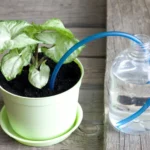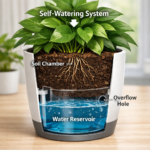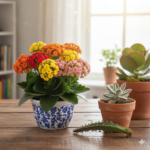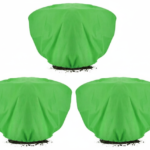The Philodendron Snowdrift, scientifically known as the Philodendron hybrid ‘Snowdrift,’ is a hybrid cultivar that combines the best traits of different Philodendron species. Its large, heart-shaped leaves feature a mesmerizing blend of green and white variegation, resembling a delicate dusting of snow. The marbled pattern, with white veins and patches, adds an elegant touch to any space.
In this blog post, we will tell you the way to discover the beauty of Philodendron Snowdrift and learn how to grow and care for this stunning plant.
About Philodendron Snowdrift
Philodendron Snowdrift is a stunning tropical plant known for its large, heart-shaped leaves with a unique blend of green, cream, and white variegation. As the plant matures, its leaves develop more striking patterns, adding a beautiful contrast to indoor spaces. This low-maintenance plant thrives in bright, indirect light but can tolerate lower light conditions. Watering should be done when the top inch of soil feels dry, avoiding overwatering to prevent root rot. With the right care, it can grow into an impressive houseplant, adding a tropical vibe to any home. Regularly clean the leaves to enhance photosynthesis and ensure the plant’s overall health. It’s perfect for plant lovers who appreciate vibrant, eye-catching foliage.
Features
Philodendron Snowdrift, is a unique and captivating plant that belongs to the family Araceae.
Known for its stunning foliage and ease of care, this particular variety of Philodendron has gained popularity among plant enthusiasts and collectors.
Here are some of its distinctive features:
Foliage

The most striking feature of the Philodendron Snowdrift is its foliage.
The leaves are a heart-shaped, glossy, and rich green color. What sets it apart is the prominent white variegation that resembles a snowdrift.
The variegation patterns can vary, ranging from bold white stripes to scattered patches, adding an enchanting and eye-catching appeal to the plant.
Size of Philodendron Snowdrift
When grown indoors, it typically reaches a height of 2 to 4 feet (60 to 120 cm) with a similar spread. Its large, elongated leaves can grow up to 10 to 12 inches (25 to 30 cm) long, especially in mature plants. This plant can develop a bushy and impressive appearance with ample space, proper light, and care. In outdoor tropical environments, it may grow even larger, spreading extensively as it matures. Its size makes it a striking statement piece in homes, offices, or green spaces. Regular pruning can help control its growth and maintain a more compact shape, ideal for smaller spaces.

Snowdrifts can reach a height of 1 to 3 feet (30 to 90 centimeters) when fully mature.
It is suitable for both indoor and outdoor cultivation, allowing it to fit well in various spaces such as shelves, desks, or small gardens.
Growth Habit
The Philodendron Snowdrift has a climbing to semi-upright growth habit, typical of many philodendrons. As a juvenile, it often grows in a more compact, bushy form, but with maturity, it can develop longer stems and exhibit a climbing or sprawling nature. When provided with a moss pole or other support, the plant can climb vertically, showcasing its beautiful variegated leaves more prominently. In its natural habitat, this growth habit allows it to climb trees or spread across the forest floor. Indoors, it thrives in pots or hanging baskets, where its foliage can trail elegantly. Its adaptable nature makes it ideal for both vertical displays and tabletop arrangements. Regular pruning helps maintain its shape and encourages bushier growth.
This philodendron has a bushy growth habit, with multiple stems emerging from the base.
As it grows, it tends to develop a more sprawling nature, creating an attractive and lush appearance.
Low-Maintenance
Philodendron Snowdrift is renowned for its easy care requirements, making it an ideal choice for beginners or busy plant lovers.
It thrives in typical indoor conditions with moderate to bright indirect light.
It can tolerate lower light levels, but the variegation may become less pronounced.
Regular watering when the top inch (2.5 centimeters) of soil feels dry, and occasional fertilization during the growing season, will keep the plant healthy and thriving.
Versatile Placement
Due to their moderate size and adaptability, Snowdrift can be placed in various locations.
It can be grown as a houseplant, adding a touch of elegance to interior spaces, or utilized as a charming addition to outdoor gardens and patio settings.
When used in hanging baskets or as a trailing plant, it creates a cascading effect, making it a great choice for vertical gardening.
Air-Purifying Qualities
Like many other philodendron varieties, Snowdrift contributes to purifying the air by removing harmful toxins and impurities.
Its broad leaves efficiently absorb pollutants such as formaldehyde, benzene, and xylene, promoting a healthier and fresher indoor environment.
Whether you’re an experienced plant enthusiast or just starting your green journey, this captivating philodendron is sure to add beauty and charm to your living space.
Is Philodendron Snowdrift Toxic?
Yes, Philodendron Snowdrift, like many other members of the Philodendron genus, is toxic to humans and pets if ingested.
It contains calcium oxalate crystals and causes irritation and discomfort when chewed or swallowed.
When the mouth, throat, and digestive systems are irritated by the crystals, it creates symptoms like swelling and burning.
It is important to keep Philodendron Snowdrift, out of reach of children and pets to prevent accidental ingestion.
It is advised to seek medical assistance or call a poison control center right away if you believe someone has consumed any component of the plant or is showing symptoms after contact.
While Philodendron Snowdrift adds beauty to indoor spaces, it is essential to handle it with care and be aware of its toxic nature to ensure the safety of everyone in the household, including curious pets.
Philodendron Snowdrift Care
Taking proper care of the Philodendron Snowdrift is essential to ensure its health and vitality. Here are some guidelines for its care:
Light
Philodendron Snowdrift thrives in moderate to bright indirect light. Place it near a window with filtered sunlight, or in a well-lit spot indoors. Avoid exposing it to direct sunlight, as it can scorch the leaves. If the variegation on the leaves starts to fade, it may indicate insufficient light, so consider providing it with a slightly brighter location.
The Philodendron Snowdrift thrives in bright, indirect light. It prefers filtered sunlight, similar to what it would receive under a forest canopy in its natural habitat. Too much direct sunlight can scorch its leaves, causing browning or fading of its beautiful variegation.
On the other hand, low light conditions can slow its growth and reduce the vibrancy of its foliage. To keep the plant healthy and thriving, place it near an east- or north-facing window or slightly back from a south- or west-facing window. If natural light is limited, grow lights can also supplement lighting. Regularly rotate the plant to ensure even light exposure and balanced growth. Proper lighting enhances its striking patterns and promotes lush, vibrant leaves.
Temperature
Philodendron Snowdrift prefers average to warm temperatures between 65-85°F (18-29°C). Avoid exposing it to sudden temperature fluctuations and drafty areas. Protect the plant from cold drafts, as exposure to cold air can cause damage to the foliage. Keep it away from heating vents or radiators, as direct heat can dry out the plant. Maintaining temperature within its preferred range helps promote healthy growth and prevents stress.
Watering
Water the Snowdrift when the top inch (2.5 centimeters) of soil feels dry. Ensure that the pot has drainage holes to prevent waterlogging, as overly wet conditions can lead to root rot. Avoid overwatering or letting the plant sit in standing water. During winter or in low light conditions, reduce the frequency of watering.
Humidity
Philodendron Snowdrift appreciates higher humidity levels. You can increase humidity by misting the leaves regularly or placing the plant on a tray filled with water and pebbles.
Alternatively, a humidifier can help maintain the ideal humidity for the plant.
Soil
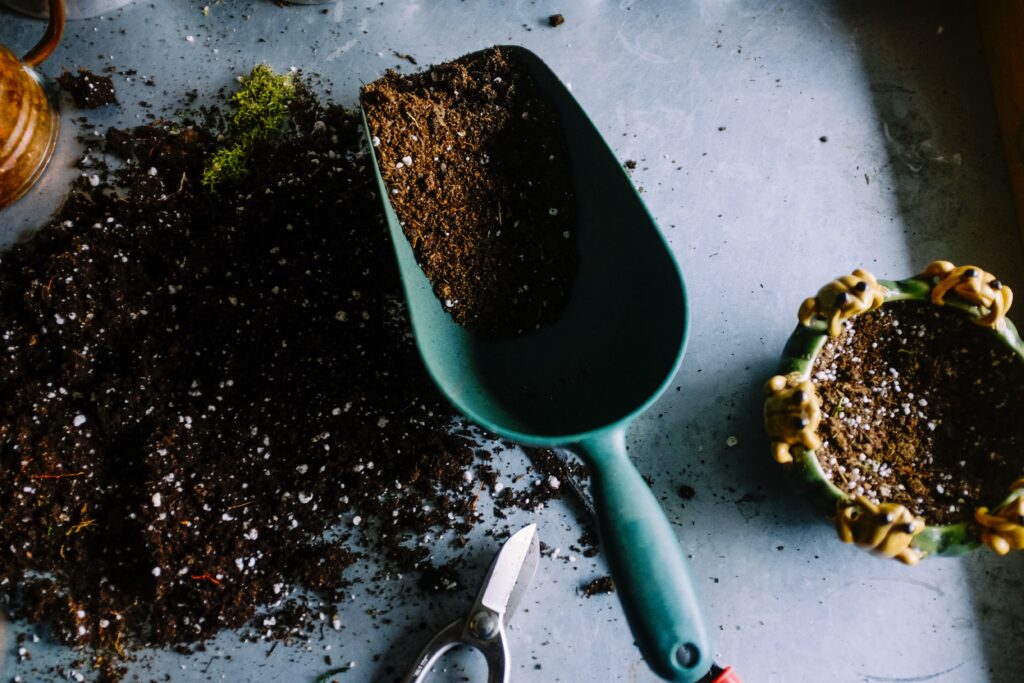
Plant the Snowdrift in a well-draining potting mix that retains some moisture but doesn’t become overly compacted.
A mix of peat moss, perlite, and orchid bark works well. Avoid using heavy soils that retain too much water.
Fertilization
The Philodendron Snowdrift benefits from regular fertilization during its active growing season, typically spring and summer. Use a balanced, water-soluble fertilizer, such as a 20-20-20 formula, diluted to half strength every 4 to 6 weeks. This provides essential nutrients to support healthy growth and vibrant foliage. Avoid over-fertilizing, as it can lead to salt buildup in the soil, which may damage the roots and cause leaf discoloration.
During the fall and winter, reduce or stop fertilization since the plant’s growth naturally slows. If using slow-release granules, apply sparingly at the beginning of the growing season. Always water the plant before fertilizing to prevent root burn. Proper fertilization ensures the Philodendron Snowdrift maintains its lush, variegated leaves and grows vigorously year-round.
Feed the Snowdrift with a balanced liquid fertilizer diluted to half the recommended strength. Apply it every two to four weeks during the growing season (spring to summer). Reduce or stop fertilizing in the winter months when the plant’s growth slows down.
Drainage: Essential for Healthy Roots
Proper drainage is essential for the healthier and bushier growth of your plant.
Ensure that your chosen pot has drainage holes at the bottom to allow excess water to pass away.
Placing a layer of pebbles or broken pottery shards at the bottom of the pot can enhance drainage by preventing the soil from blocking the drainage holes.
Potting: Creating the Ideal Growing Medium
When potting your Philodendron Snowdrift, it’s important to use a suitable growing medium. A well-draining potting mix is ideal, providing a balance of moisture retention and proper aeration. A mix containing peat moss, perlite, orchid bark, or other organic matter works well. Avoid using heavy or compacted soils, as they can hinder drainage and lead to root issues.
To pot your Philodendron Snowdrift gently remove it from its current container, taking care not to damage the roots. Make sure the soil level is the same depth as before and set the plant in the center of the new pot.
Fill in the gaps with the potting mix, gently firming it around the roots. Avoid packing the soil too tightly, as it can hinder proper root growth.
Pruning Philodendron Snowdrift
Regular pruning helps maintain the appearance and health of your Philodendron Snowdrift. Remove any yellowing or damaged leaves promptly to encourage new growth. Trimming back leggy vines also promotes bushier growth.
Use clean, sharp pruning shears or scissors to make clean cuts just above a leaf node. Pruning can be done throughout the year as needed. Always sanitize your pruning tools before use to prevent the spread of diseases.
Propagation of Philodendron Snowdrift
Propagation of Philodendron Snowdrifts can be successfully accomplished using several methods, including stem cuttings and air layering. Here are the details of each propagation method:
Stem Cuttings

- Select a healthy stem with at least two nodes (the points where leaves emerge).
- Make a clean cut just below a node using a clean, sharp knife or scissors.
- Remove the lower leaves, leaving a few leaves at the top intact.
- Apply a rooting hormone to the cut end of the stem to encourage faster root growth.
- Place the cutting in a container with water or well-draining soil, as explained in the previous response.
- Maintain appropriate lighting, humidity, and moisture levels, ensuring the cutting receives indirect light and remains consistently moist.
- Roots will develop over time, and once they have grown to a sufficient length, transplant the cutting into a pot with regular potting soil.
Air Layering
Air layering is a more advanced propagation method but can be effective for Philodendron Snowdrifts.
- Select a healthy stem and make a small horizontal cut or remove a thin strip of bark about halfway through the branch.
- Dust the area with rooting hormone powder (optional).
- Apply moist sphagnum moss around the wounded area and wrap it with plastic wrap, securing the ends tightly.
- Ensure the moss remains consistently moist and provides indirect light to the area.
- After several weeks or when roots have developed, carefully cut below the rooted section, keeping the new plant intact.
- Pot the new plant in well-draining soil and provide appropriate care.
Both methods have their advantages. Stem cuttings are more commonly used and relatively easier for beginners, while air layering requires a bit more skill and patience but can result in a more established plant from the start.
With time and care, you can successfully propagate new Philodendron Snowdrift plants and expand your collection.
Common Leaf Issues in Philodendron Snowdrift
Philodendron Snowdrifts, like other plants, can sometimes experience leaf issues that may indicate underlying problems.
Here are some common leaf issues you may encounter with Philodendron Snowdrift and their potential causes:
Yellowing Leaves
Yellowing leaves can occur due to various reasons, including overwatering, underwatering, nutrient deficiencies, or natural aging.
Assess the plant’s watering routine and adjust accordingly, ensuring the soil is neither too dry nor waterlogged.
Consider fertilizing the plant with a balanced fertilizer to provide the necessary nutrients.
If the yellowing is limited to older leaves at the bottom of the plant, it may be a natural process as new leaves emerge.
Brown Spots or Edges:
Brown spots or edges on the leaves can be caused by inconsistent watering, underwatering, or low humidity.
Check the soil moisture regularly and water the plant when the top inch (2.5 centimeters) of soil becomes slightly dry.
Increase humidity levels by misting the leaves or using a humidifier.
Avoid using water with high salt content, as it can cause leaf burn.
Leaf Curling
Leaf curling can be a response to dry air, low humidity, or inadequate watering.
Increase humidity levels around the plant by misting the leaves or placing a tray of water nearby.
Ensure the plant receives adequate watering, allowing the soil to dry slightly between waterings.
In some cases, curling leaves can also be caused by excessively high temperatures or direct sunlight, so adjust the plant’s placement accordingly.
Leaf Spotting or Discoloration
Leaf spots can occur due to fungal or bacterial infections, as well as pest infestations.
Treat any visible pests with appropriate measures, such as insecticidal soap or natural predators.
For fungal or bacterial issues, consider using a fungicide or adjusting environmental conditions to discourage disease development.
Remove and dispose of severely affected leaves to prevent further spread.
Leggy Growth
Leggy growth refers to long, stretched-out stems with widely spaced leaves.
It is typically a result of insufficient light levels.
Increase the plant’s exposure to bright, indirect light to encourage compact and bushier growth.
Pruning back leggy stems can also help promote a fuller appearance.
Leaf Drop
Some leaf drop is a natural process as older leaves age and make way for new growth.
However, excessive leaf drop can indicate stress factors such as over or underwatering, abrupt changes in temperature or lighting, or root issues.
Assess the plant’s conditions and adjust as needed, providing stable and suitable growing conditions.
Regularly inspecting your Philodendron Snowdrift’s leaves can help you identify and address any issues promptly.
Pests And Diseases of Philodendron Snowdrift
Philodendron Snowdrift is generally a resilient plant, but like any other houseplant, it can be susceptible to certain pests and diseases.
Here are some common pests and diseases that may affect Philodendron Snowdrift and how to deal with them:
Pests
Aphids
Aphids are small, soft-bodied insects that can gather new growth, causing curling and distortion. They can be found clustered on new growth, undersides of leaves, or along stems.
Use a strong stream of water to wash off aphids from the plant. Alternatively, you can apply insecticidal soap or neem oil following the product instructions. Repeat treatments may be necessary to fully eliminate the infestation.
Spider Mites
Spider mites are tiny pests that can cause webbing on the leaves and damage the plant by piercing the cells and sucking out the sap.
Regularly misting the leaves to increase humidity can help deter spider mites. If an infestation occurs, you can use insecticidal soap, neem oil, or horticultural oil following the product instructions. Ensure thorough coverage, targeting the undersides of leaves.
Mealybugs

Mealybugs are small, cotton-like insects that gather in clusters. They can be found on leaf joints, leaf undersides, and along stems. Infested areas may appear white or have a sticky residue.
Remove mealybugs manually using a cotton swab dipped in rubbing alcohol or soapy water. For severe infestations, you can use insecticidal soap or neem oil following the product instructions.
Scale Insects
Scale insects are small, oval-shaped pests that attach themselves to the plant and form a protective shell. They can be brown, black, or tan in color and often appear as raised bumps on leaves or stems.
Gently scrape off-scale insects using a soft brush or your fingernail. You can also use insecticidal soap or neem oil following the product instructions. Repeat treatments may be necessary to target newly hatched scales.
Diseases
Leaf Spot
Leaf spot diseases are fungal or bacterial infections that cause spots or lesions on the leaves. The spots may vary in color, including brown, black, or yellow, and can sometimes have a concentric ring pattern.
Remove and destroy any infected leaves to prevent the spread of the disease. Ensure proper air circulation and avoid overhead watering to minimize moisture on the foliage. Applying a fungicide or bactericide following the product instructions can help manage severe cases.
Root Rot
Root rot is caused by overwatering or poorly draining soil, leading to the decay of the plant’s roots. Symptoms include wilting, yellowing leaves, and a foul odor from the soil.
Address root rot by improving drainage conditions. Allow the soil to dry out slightly between waterings and ensure the pot has adequate drainage holes. Trim any affected roots and repot the plant using fresh, well-draining soil.
By staying vigilant and taking prompt action when necessary, you can effectively manage and mitigate pest and disease issues in your beloved Philodendron Snowdrift, ensuring its continued health and vibrancy.
Philodendron Snowdrift VS Whipply Way
Both Philodendron Snowdrift and Philodendron Whipple Way are popular cultivars within the Philodendron genus.
Here’s a comparison between Philodendron Snowdrift and Philodendron Whipple Way:
Appearance
- Snowdrift: Philodendron Snowdrift features large, heart-shaped leaves with a predominantly green coloration and prominent white variegation or marbling. The variegation is often more pronounced on the newer leaves.
- Whipple Way: Philodendron Whipple Way showcases elongated, lance-shaped leaves that are typically solid green without variegation. The leaves have a glossy texture and can grow quite long.
Growth Habit
- Snowdrift: Snowdrift is a relatively compact and bushy plant, with leaves growing closely together. It tends to have a more upright growth habit and can reach a moderate height.
- Whipple Way: Whipple Way has a trailing or cascading growth habit, making it well-suited for hanging baskets or climbing up supports. The stems can become quite long, giving it a more vine-like appearance.
Variegation
- Snowdrift: The standout feature of Snowdrift is its striking white variegation on the leaves, which gives the plant a distinctive and eye-catching appearance.
- Whipple Way: Unlike Snowdrift, Whipple Way does not possess variegation. Its leaves are uniformly green, showcasing a classic philodendron look.
Care Requirements
Snowdrift and Whipple Way have similar care needs.
They both thrive in well-draining potting soil and prefer moderate to bright indirect light.
They can tolerate some shade but may lose some variegation in lower light conditions.
Water the plants when the top inch of soil is dry, avoiding overwatering.
Additionally, they benefit from occasional misting to increase humidity levels.
Availability
Snowdrift and Whipple Way may vary in availability depending on your location and local nurseries or suppliers.
Snowdrift is a relatively newer cultivar and may be less commonly found compared to more widely available varieties.
Whipple Way, on the other hand, has been sometimes more available in certain markets.
Which One Is Better?
When deciding between Philodendron Snowdrift and Philodendron Whipple Way, consider your preference for variegation, growth habit, and availability.
Both plants can be excellent additions to your indoor plant collection, offering unique features and the signature beauty of the Philodendron genus.
Philodendron Jungle Fever VS Philodendron Snowdrift
Philodendron Jungle Fever and Philodendron Snowdrift are distinct cultivars within the Philodendron genus, each with its own unique characteristics. Here’s a comparison between Philodendron Jungle Fever and Philodendron Snowdrift:
Leaf Appearance
- Jungle Fever: Philodendron Jungle Fever features large, glossy leaves with a deep green color and prominent white or cream-colored veins. The veins create an intricate pattern, resembling a “fever” of lines on the foliage.
- Snowdrift: Philodendron Snowdrift, on the other hand, showcases large, heart-shaped leaves with a predominantly green coloration and striking white variegation or marbling. The variegation can be more pronounced on newer leaves and gives the plant a unique and eye-catching look.
Growth Habit
- Jungle Fever: Philodendron Jungle Fever typically has an upright growth habit, with leaves growing more vertically. It can develop into a relatively compact plant, making it suitable for tabletop or shelf displays.
- Snowdrift: Philodendron Snowdrift has a bushier growth habit, with leaves growing closely together. It tends to have a more upright growth pattern but can also develop trailing vines if given the opportunity.
Variegation
- Jungle Fever: The notable feature of Jungle Fever is its contrasting white or cream-colored veins that run through the dark green leaves. This unique variegation adds visual interest to the foliage.
- Snowdrift: Snowdrift stands out for its prominent white variegation or marbling across the leaves, creating a beautiful contrast against the green background.
Care Requirements
Both Jungle Fever and Snowdrift have similar care requirements. They thrive in well-draining potting soil and prefer moderate to bright indirect light. They can tolerate some shade but may lose some variegation in lower light conditions. Water the plants when the top inch of soil is dry, avoiding overwatering. Additionally, they benefit from occasional misting to increase humidity levels.
Availability
Availability may vary depending on your location and local nurseries or suppliers. Both Jungle Fever and Snowdrift can be sought-after cultivars and may be more readily available in certain markets or at specific times.
Which One Is Better?
When deciding between Philodendron Jungle Fever and Philodendron Snowdrift, consider your preference for leaf appearance, variegation patterns, and growth habits. Both cultivars offer unique visual features that can enhance any indoor plant collection.
Where to Buy Philodendron Snowdrift
If you want to buy Philodendron Snowdrift, you can purchase it both online and offline. Here several options are available to you:
Local Plant Nurseries
Visit your local plant nurseries or garden centers. They may have Philodendron Snowdrift in stock or be able to order it for you.
Online Plant Retailers for Philodendron Snowdrift
Explore online plant retailers that specialize in rare and exotic plants. Websites like Etsy, Amazon, eBay, and specialized plant shops often offer a variety of Philodendron Snowdrift plants for purchase.
Plant Enthusiast Groups
Join online plant enthusiast groups or forums on social media platforms. These communities often have members who trade, sell, or propagate Philodendron Snowdrift plants.
Plant Expos or Farmers’ Markets
Check for plant expos or farmers’ markets in your area. These events can be great places to find unique plant varieties, including philodendron Snowdrifts.
Remember to read reviews, check seller ratings, and ensure that the plants are sourced ethically and shipped with care. Always choose reputable sellers to ensure the quality and health of your Philodendron Snowdrift plant.
FAQs
What is a Philodendron Snowdrift?
Philodendron Snowdrift is a cultivar within the Philodendron genus known for its large, heart-shaped leaves with striking white variegation or marbling patterns. It is a popular houseplant choice due to its unique foliage.
Is Philodendron Snowdrift rare?
Philodendron Snowdrift is considered relatively rare compared to more common Philodendron varieties. Its distinct variegation and limited availability make it a sought-after plant among collectors and enthusiasts.
What is the difference between variegated Jungle Fever and Snowdrift?
The main difference between variegated Jungle Fever and Snowdrift lies in their leaf patterns. Jungle Fever features deep green leaves with prominent white or cream-colored veins, resembling a “fever” of lines. In contrast, Snowdrift displays predominantly green leaves with white variegation or marbling throughout, creating a distinct and eye-catching appearance.
Is Philodendron Snowdrift a climbing plant?
Philodendron Snowdrift is not a climbing plant by nature. It tends to have an upright growth habit with bushy foliage.
Are Philodendron Snowdrift and Jungle Fever the same?
While both Snowdrift and Jungle Fever belong to the Philodendron genus, they are separate cultivars with distinct leaf characteristics.
What color is Philodendron Snowdrift?
Philodendron Snowdrift features predominantly green leaves with prominent white variegation or marbling. The combination of green and white creates a visually striking contrast, adding to its allure.
How do you care for a Philodendron Snowdrift?
To care for a Philodendron Snowdrift, provide it with well-draining potting soil and place it in an area with moderate to bright indirect light. Water the plant when the top inch of soil feels dry and avoid overwatering. Maintain a moderate level of humidity by misting the leaves or using a humidifier. Regularly dust the leaves to keep them clean and free from dust buildup.
What is the scientific name of the Philodendron Snowdrift?
The scientific name of Philodendron Snowdrift is Philodendron X ‘Snowdrift’. It is a hybrid plant that was created by crossing Philodendron Giganteum with Philodendron Pinnatifidum.
Conclusion
In conclusion, Philodendron Snowdrift is a captivating cultivar within the Philodendron genus. Its large, heart-shaped leaves with striking white variegation or marbling make it a desirable choice for plant enthusiasts. While relatively rare, Snowdrift adds a touch of elegance to any indoor space. It requires proper care, including well-draining soil, moderate to bright indirect light, and regular watering. By providing suitable conditions, you can enjoy the beauty and unique features of the Philodendron Snowdrift, making it a standout addition to your plant collection.
You may also like


